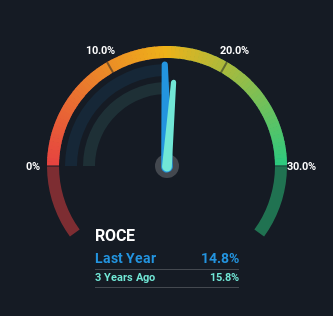Capital Allocation Trends At Kansai Nerolac Paints (NSE:KANSAINER) Aren't Ideal

To find a multi-bagger stock, what are the underlying trends we should look for in a business? Typically, we'll want to notice a trend of growing return on capital employed (ROCE) and alongside that, an expanding base of capital employed. If you see this, it typically means it's a company with a great business model and plenty of profitable reinvestment opportunities. Although, when we looked at Kansai Nerolac Paints (NSE:KANSAINER), it didn't seem to tick all of these boxes.
Understanding Return On Capital Employed (ROCE)
If you haven't worked with ROCE before, it measures the 'return' (pre-tax profit) a company generates from capital employed in its business. Analysts use this formula to calculate it for Kansai Nerolac Paints:
Return on Capital Employed = Earnings Before Interest and Tax (EBIT) ÷ (Total Assets - Current Liabilities)
0.15 = ₹8.3b ÷ (₹71b - ₹15b) (Based on the trailing twelve months to December 2023).
So, Kansai Nerolac Paints has an ROCE of 15%. In absolute terms, that's a pretty normal return, and it's somewhat close to the Chemicals industry average of 14%.
View our latest analysis for Kansai Nerolac Paints

Above you can see how the current ROCE for Kansai Nerolac Paints compares to its prior returns on capital, but there's only so much you can tell from the past. If you'd like to see what analysts are forecasting going forward, you should check out our free report for Kansai Nerolac Paints.
The Trend Of ROCE
When we looked at the ROCE trend at Kansai Nerolac Paints, we didn't gain much confidence. To be more specific, ROCE has fallen from 19% over the last five years. On the other hand, the company has been employing more capital without a corresponding improvement in sales in the last year, which could suggest these investments are longer term plays. It may take some time before the company starts to see any change in earnings from these investments.
Our Take On Kansai Nerolac Paints' ROCE
Bringing it all together, while we're somewhat encouraged by Kansai Nerolac Paints' reinvestment in its own business, we're aware that returns are shrinking. And investors may be recognizing these trends since the stock has only returned a total of 8.9% to shareholders over the last five years. So if you're looking for a multi-bagger, the underlying trends indicate you may have better chances elsewhere.
Since virtually every company faces some risks, it's worth knowing what they are, and we've spotted 3 warning signs for Kansai Nerolac Paints (of which 1 doesn't sit too well with us!) that you should know about.
While Kansai Nerolac Paints may not currently earn the highest returns, we've compiled a list of companies that currently earn more than 25% return on equity. Check out this free list here.
Valuation is complex, but we're here to simplify it.
Discover if Kansai Nerolac Paints might be undervalued or overvalued with our detailed analysis, featuring fair value estimates, potential risks, dividends, insider trades, and its financial condition.
Access Free AnalysisHave feedback on this article? Concerned about the content? Get in touch with us directly. Alternatively, email editorial-team (at) simplywallst.com.
This article by Simply Wall St is general in nature. We provide commentary based on historical data and analyst forecasts only using an unbiased methodology and our articles are not intended to be financial advice. It does not constitute a recommendation to buy or sell any stock, and does not take account of your objectives, or your financial situation. We aim to bring you long-term focused analysis driven by fundamental data. Note that our analysis may not factor in the latest price-sensitive company announcements or qualitative material. Simply Wall St has no position in any stocks mentioned.
About NSEI:KANSAINER
Kansai Nerolac Paints
Manufactures and supplies paints and varnishes, enamels, and lacquers in India.
Flawless balance sheet established dividend payer.
Similar Companies
Market Insights
Community Narratives



